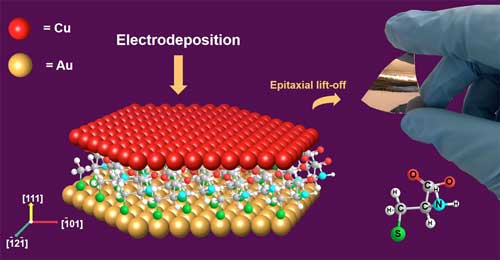| Sep 30, 2020 | |
Researchers use amino acids to grow high-performance copper thin films(Nanowerk News) For the first time, researchers from Missouri S&T have shown that highly ordered copper thin films can be crystallized directly on a one-molecule-thick layer of organic material rather than on the inorganic substrates that have been used for years (Journal of Physical Chemistry C, "Epitaxial Electrodeposition of Cu(111) onto an L-cysteine Self- assembled Monolayer on Au(111) and Epitaxial Lift-off of Single-crystal-like CuFoils for Flexible Electronics"). |
|
 |
|
| Copper thin films are created by electrodeposition of copper, Cu(111), on a self-assembled organic monolayer of the amino acid L-cysteine on gold, Au(111). (Image: Bin Luo) (click on image to enlarge) | |
| The copper thin films they’ve produced are excellent candidates for use as underlying substances for solar cells, LEDs, and high-temperature superconductors, says Dr. Jay Switzer, Chancellor’s Professor and Curators’ Distinguished Professor emeritus of chemistry, who is principal investigator of the project. | |
| Switzer says that other researchers have previously electroplated thin films onto self-assembled monolayers (SAMs) of organic molecules, but those films lacked the in-plane and out-of-plane order required for electronic applications. | |
| “Like the way seashells, bones or teeth are formed, we’ve found a way to give the copper films the right level of crystalline order and durability for their applications,” says Switzer. “With our process, which mimics biomineralization, we’re creating inorganic thin films with superior qualities of single-crystal-like order, high conductivity and flexibility.” | |
| In their experiments, the researchers electrodeposited copper on a single layer of L-cysteine, a protein- building amino acid that was placed on ordered layers of gold on silicon. After the copper crystallized into an ordered film, they were able to lift off a single, crystal-like foil simply using adhesive tape. | |
| Their process provides an inexpensive route to free-standing metal foils with properties that mimic those of expensive single crystals, the researchers note. | |
| Switzer says their method shows the importance of the cysteine molecule in directing the growth of ordered crystalline structures. As a contribution to science, he notes the method will enable future work on the deposition of ordered films of other important materials such as semiconductors and catalysts onto organic self-assembled monolayers. The method may also prove to minimize the effects of lattice mismatch that sometimes limit epitaxial, or crystalline, growth. |
| Source: By Delia Croessmann, Missouri University of Science and Technology | |
|
Subscribe to a free copy of one of our daily Nanowerk Newsletter Email Digests with a compilation of all of the day's news. |
